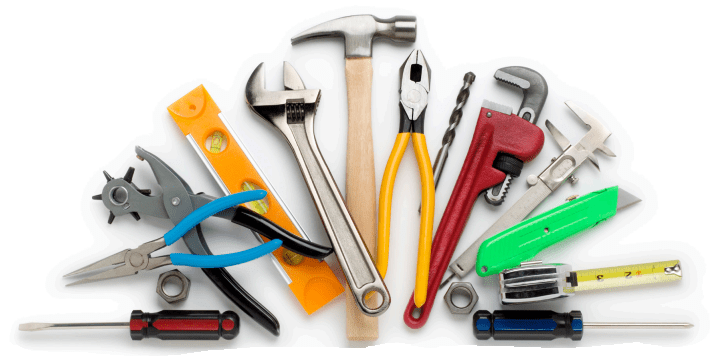Hand tools are essential instruments used for various tasks, from basic repairs and maintenance to intricate construction projects. These manually operated devices have been an integral part of human civilization for centuries, evolving alongside our technological advancements.
At their core, hand tools are designed to extend and amplify the capabilities of our hands, allowing us to apply greater force, precision, and control over materials. They serve as vital companions in countless professions, from carpentry and plumbing to automotive repair and gardening.
The importance of hand tools lies in their versatility and accessibility. Unlike complex machinery, these tools can be easily transported and utilized in various settings, making them indispensable for on-site work, DIY projects, and emergency repairs. Their simplicity and durability have made them a staple in toolboxes and workshops worldwide.
Throughout history, hand tools have played a crucial role in shaping our built environment and advancing human ingenuity. From the earliest stone tools used by our ancestors to the specialized instruments of modern trades, these tools have been instrumental in constructing everything from primitive shelters to towering skyscrapers.
Table of Contents
Hammer
A hammer is a versatile hand tool that consists of a handle and a head, typically made of metal. It is primarily used for striking objects, driving nails, and shaping materials. The hammer’s design allows the user to apply a concentrated force, making it an essential tool in various tasks, such as construction, carpentry, and home improvement projects.
Description:
The head of a hammer is the striking surface, which can be flat, curved, or have a specific shape depending on its intended use. The handle, usually made of wood, fiberglass, or steel, provides leverage and a comfortable grip for the user.
Types of Hammers:
- Claw Hammer: This is the most common type of hammer, featuring a flat head on one side and a curved claw on the other. The flat head is used for driving nails, while the claw is designed for removing nails or prying apart materials.
- Ball-Peen Hammer: This hammer has a round, ball-shaped head on one side and a flat, peen-shaped head on the other. It is primarily used in metalworking tasks, such as shaping, riveting, and straightening metal.
- Mallet: A mallet is a type of hammer with a large, cylindrical head made of rubber, wood, or plastic. It is used for striking surfaces without damaging them, making it ideal for woodworking, upholstery, and assembling furniture.
- Sledgehammer: A sledgehammer is a heavy-duty hammer with a large, flat head and a long handle. It is designed for demolition work, breaking concrete, and driving stakes or posts into the ground.
Uses:
Hammers are versatile tools used for a variety of tasks, including:
- Driving nails into wood or other materials
- Removing nails or prying apart materials
- Shaping and straightening metal (ball-peen hammer)
- Striking surfaces without causing damage (mallet)
- Demolition work and breaking concrete (sledgehammer)
Safety Tips:
- Always wear safety glasses or goggles to protect your eyes from flying debris.
- Ensure a secure grip on the hammer’s handle to prevent it from slipping and causing injury.
- Keep your non-striking hand away from the striking area to avoid accidental hits.
- Use the appropriate hammer for the task at hand to prevent damage or injury.
- Maintain proper stance and balance while using a hammer to avoid strain or falls.
Hammers are essential hand tools that serve various purposes in construction, carpentry, metalworking, and home improvement projects. Proper selection, use, and safety precautions are crucial for effective and safe hammering tasks.
Screwdriver
A screwdriver is an essential hand tool used for driving and removing screws. It consists of a handle and a tip that fits into the head of a screw, allowing for rotational force to be applied. There are several types of screwdrivers, each designed to work with specific screw head styles.
Description:
The most common types of screwdrivers are the flat-head (also known as slotted) and the Phillips-head. The flat-head screwdriver has a single, straight blade that fits into a straight, linear slot in the screw head. The Phillips-head screwdriver has a cruciform tip that fits into a cross-shaped recess in the screw head.
Types:
- Flat-head (Slotted) Screwdriver: Used for screws with a single, straight slot in the head.
- Phillips-head Screwdriver: Used for screws with a cross-shaped recess in the head.
- Pozidriv Screwdriver: Similar to a Phillips-head but with additional grooves for better grip and reduced cam-out.
- Torx Screwdriver: Used for screws with a star-shaped recess, commonly found in electronics and automotive applications.
- Robertson Screwdriver: Used for screws with a square recess, popular in Canada and some parts of the United States.
Uses:
Screwdrivers are versatile tools used for a wide range of applications, including assembling and disassembling furniture, electronics, machinery, and various household items. They are also commonly used in construction, carpentry, and repair work.
Tips for Proper Usage:
- Always use the correct type and size of screwdriver for the screw head to avoid damaging the screw or the tool.
- Apply firm, even pressure and turn the screwdriver in the appropriate direction (clockwise to tighten, counterclockwise to loosen).
- For stubborn screws, try tapping the screwdriver handle gently with a mallet or using a screwdriver with a larger handle for better leverage.
- Keep screwdrivers in good condition by regularly inspecting and replacing worn or damaged tips.
- Use caution when working with screwdrivers to avoid slipping and potential injuries.
Wrench
A wrench is a hand tool used for gripping, turning, or tightening nuts, bolts, and other threaded fasteners. It consists of a handle and a jaw or opening at one end, designed to fit snugly around the head of a nut or bolt. Wrenches are essential tools in various industries, including construction, automotive repair, plumbing, and machinery maintenance.
There are several types of wrenches, each designed for specific applications:
- Open-End Wrench: This wrench has a U-shaped opening at one end, allowing it to fit around a nut or bolt head. Open-end wrenches are versatile and can be used in tight spaces, but they can also slip off the fastener if not positioned correctly.
- Box-End Wrench: Also known as a closed-end wrench, this type has a closed loop or “box” at one end that completely surrounds the nut or bolt head. Box-end wrenches provide a more secure grip and are less likely to slip off, making them ideal for applications where a firm hold is required.
- Adjustable Wrench: This wrench has a movable jaw that can be adjusted to fit various sizes of nuts and bolts. Adjustable wrenches are versatile and convenient, as they can be used on a wide range of fastener sizes. However, they may not provide as secure a grip as fixed-size wrenches.
Wrenches are commonly used for tasks such as tightening or loosening nuts and bolts, assembling or disassembling machinery, and performing general maintenance and repair work. When selecting a wrench, consider the size and type of fastener you’ll be working with, as well as the amount of space available and the required torque.
To ensure proper use and safety, it’s essential to choose the right wrench for the job. Using the wrong size or type of wrench can damage the fastener or the tool itself, and it can also increase the risk of injury. Always inspect the wrench for any signs of wear or damage before use, and apply appropriate force without excessive strain.
Pliers
Pliers are a versatile hand tool that consist of two lever-like handles joined by a pivot. They are designed to grip, bend, cut, or manipulate objects with their jaws or cutting edges. Pliers are an essential tool in many trades, from construction and plumbing to electronics and jewelry making.
Description: Pliers typically feature serrated jaws that provide a firm grip on materials. The handles are designed to provide leverage, allowing the user to exert greater force on the object being gripped or manipulated. The pivot point allows the jaws to open and close, making it easy to grasp and release objects.
Types of Pliers:
- Slip-joint Pliers: These are the most common type of pliers, featuring adjustable jaws that can be tightened or loosened to grip objects of varying sizes. Slip-joint pliers are versatile and can be used for gripping, bending, and light cutting tasks.
- Locking Pliers: Also known as “Vise-Grips,” locking pliers have a locking mechanism that allows the jaws to remain clamped onto an object without the need for continuous hand pressure. These are particularly useful for holding workpieces securely during repair or assembly tasks.
- Needle-nose Pliers: These pliers feature long, slender jaws that come to a fine point, making them ideal for working in tight spaces or with small components. Needle-nose pliers are commonly used in electronics, jewelry making, and precision work.
Uses: Pliers are versatile tools with a wide range of applications. They can be used for gripping and turning nuts, bolts, and other fasteners, bending and shaping wire or metal, cutting wires or thin materials, and crimping or compressing components. Pliers are also useful for reaching into tight spaces or holding workpieces securely during assembly or repair tasks.
Grip Strength and Leverage: The grip strength and leverage provided by pliers are their key advantages. The serrated jaws and leverage action allow users to exert significant gripping force on objects, making it easier to hold or manipulate them. The longer the handles, the greater the leverage and gripping force that can be applied. However, it’s important to exercise caution and avoid applying excessive force, as this can damage the tool or the workpiece.
Utility Knife
A utility knife, also known as a box cutter or a Stanley knife, is a versatile hand tool that features a sharp, retractable blade. It is designed for cutting a wide range of materials, including cardboard, plastic, rope, and even drywall or roofing materials.
The utility knife’s primary function is cutting, and it excels at tasks such as opening boxes, trimming materials, and scoring surfaces for clean breaks. Its compact size and portability make it a convenient tool to carry around, whether at home, in the workshop, or on a job site.
One of the key features of a utility knife is its replaceable blade. As the blade dulls or becomes damaged, it can be easily removed and replaced with a new, sharp blade. This ensures that the tool remains effective and safe to use over time.
When using a utility knife, it is crucial to exercise caution and follow proper safety protocols. Always cut away from your body and keep your non-cutting hand out of the path of the blade. Additionally, retract the blade when not in use to prevent accidental cuts or injuries.
To ensure optimal performance and longevity, it is essential to maintain your utility knife properly. This includes regularly cleaning the tool, lubricating the blade mechanism, and replacing dull or damaged blades promptly. Proper maintenance not only enhances the tool’s effectiveness but also contributes to a safer working environment.
Hand Tool Maintenance
Proper maintenance is crucial for extending the lifespan and ensuring the safe operation of hand tools. Regular cleaning, proper storage, and occasional sharpening (for applicable tools) can help keep your tools in top condition and prevent premature wear or damage.
Cleaning: After each use, clean your hand tools thoroughly to remove any dirt, debris, or residue. Use a wire brush or steel wool to remove rust or corrosion. For stubborn grime, you can use a degreaser or mild solvent. Dry the tools completely before storing them to prevent rust.
Storage: Store your hand tools in a clean, dry place, away from moisture and extreme temperatures. Consider investing in a toolbox or pegboard to keep your tools organized and easily accessible. Avoid tossing tools into a drawer or bucket, as this can cause damage and make it difficult to find the tool you need.
Sharpening: Tools with cutting edges, such as knives, chisels, and scissors, will eventually become dull with regular use. Dull tools not only perform poorly but can also be dangerous to use. Sharpen these tools periodically using a sharpening stone, file, or rotary tool to maintain their cutting ability and extend their lifespan.
Extending Tool Life: In addition to regular maintenance, there are a few other tips to help extend the life of your hand tools:
- Use the right tool for the job: Using a tool for a purpose it wasn’t designed for can cause damage and shorten its lifespan.
- Avoid excessive force: Don’t apply too much force when using hand tools, as this can cause them to bend, break, or become damaged.
- Replace worn or damaged tools: If a tool becomes excessively worn or damaged, it’s best to replace it rather than continue using it in that condition.
By following these maintenance practices, you can ensure that your hand tools remain in good working condition and serve you well for years to come.
Safety Precautions
Proper usage of hand tools is crucial for preventing injuries and ensuring a safe work environment. Always read and follow the manufacturer’s instructions carefully. Use each tool for its intended purpose and avoid improper or excessive force, which can cause the tool to break or slip, leading to potential harm.
Personal protective equipment (PPE) is essential when working with hand tools. Wear appropriate safety glasses or goggles to protect your eyes from flying debris or particles. Gloves can help prevent cuts and provide a better grip on tools. Depending on the task, you may also need to wear steel-toed boots, hard hats, or hearing protection.
Maintaining a well-organized and clutter-free workspace is vital for safety. Keep tools in their designated storage areas when not in use, and ensure that work surfaces are clear of unnecessary items that could cause tripping hazards or interfere with your movements. Proper lighting is also essential for visibility and to prevent eye strain.
Choosing the Right Hand Tool
Selecting the appropriate hand tool is crucial for completing a task efficiently and safely. Several factors should be considered when choosing the right tool for the job:
Task and Material: Evaluate the specific task at hand and the materials you’ll be working with. Different tools are designed for various purposes, such as cutting, prying, gripping, or striking. For example, a utility knife is suitable for cutting cardboard or thin materials, while a hammer is necessary for driving nails or striking objects.
Force Required: Assess the amount of force needed for the task. If significant force is required, opt for tools with larger handles or longer levers, as they provide better leverage and reduce the effort required. For tasks requiring precision and delicate movements, choose smaller tools that offer better control and maneuverability.
Quality and Durability: Invest in high-quality hand tools from reputable manufacturers. Quality tools are typically made from durable materials, such as heat-treated steel or forged alloys, ensuring they can withstand heavy use and last longer. Look for tools with ergonomic designs that fit comfortably in your hand, reducing fatigue and increasing control.
When choosing hand tools, consider the long-term investment. While high-quality tools may be more expensive initially, they often provide better performance, increased safety, and a longer lifespan, making them a cost-effective choice in the long run. Regularly maintaining and properly storing your hand tools can further extend their durability and ensure they remain in top working condition.
Conclusion
Hand tools are essential for any household, workshop, or construction site. They enable us to perform a wide range of tasks, from simple repairs and DIY projects to complex construction and maintenance work. Investing in high-quality hand tools is crucial, as they not only ensure durability and longevity but also enhance safety and efficiency.
While power tools have become increasingly popular, hand tools remain indispensable. They offer precision, control, and the ability to work in tight spaces or areas without access to electricity. Additionally, hand tools are often more cost-effective and environmentally friendly, as they do not rely on batteries or fuel.
Proper maintenance and care of hand tools are essential to prolong their lifespan and ensure optimal performance. Regular cleaning, sharpening, and storage in a dry and organized space can prevent rust, damage, and premature wear and tear.
In conclusion, hand tools are versatile, reliable, and invaluable assets for any individual or professional. Whether you’re a homeowner, hobbyist, or tradesperson, investing in a high-quality set of hand tools is a wise decision that will pay dividends in the long run. Embrace the simplicity, control, and satisfaction that comes with using hand tools, and embark on a journey of skill, craftsmanship, and self-reliance.



